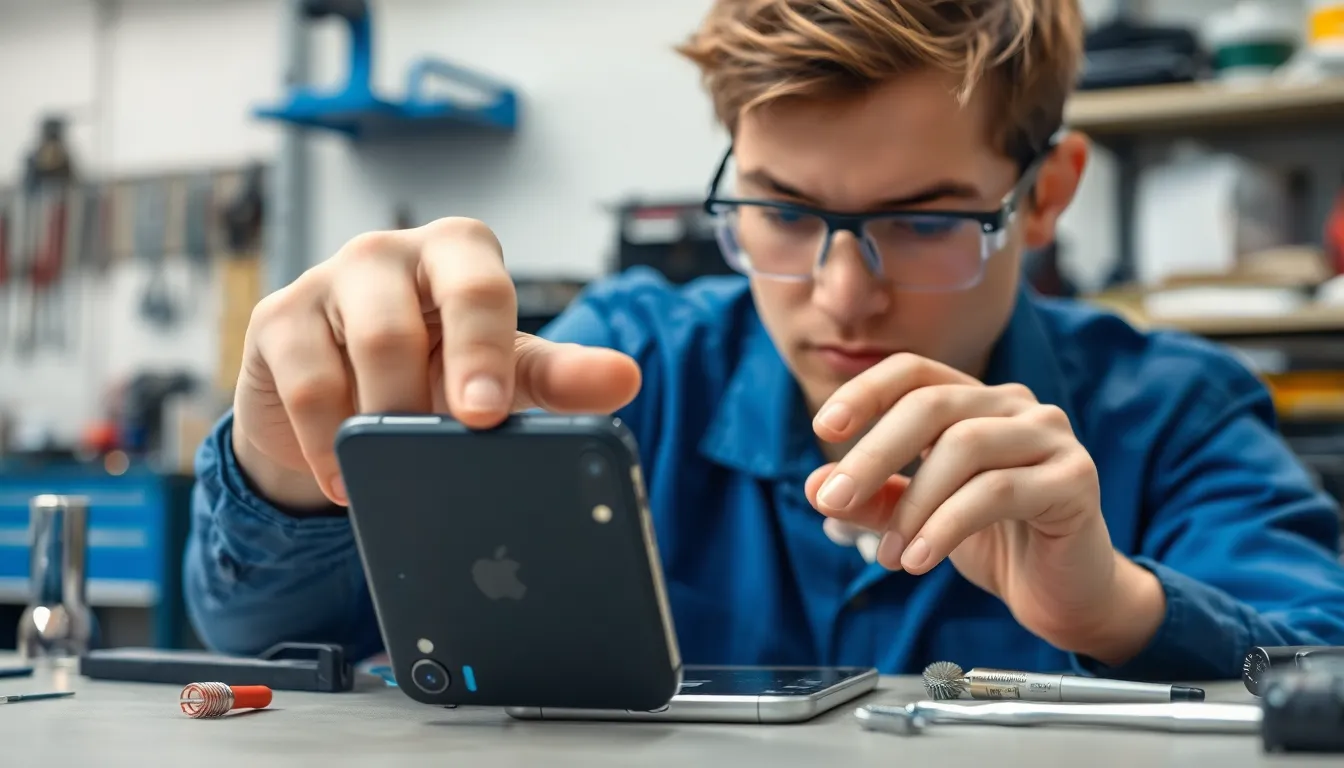Table of Contents
TogglePicture this: you’re enjoying a refreshing drink, and in a split second, your iPhone takes an unexpected dive into the depths of your beverage. Panic sets in as you wonder how much it’ll cost to rescue your beloved device from its watery grave. Water damage can be a nightmare, but knowing what to expect can save you from drowning in repair costs.
Understanding Water Damage on iPhones
Water damage often leads to significant repair costs and anxiety. Recognizing the causes and symptoms can help in addressing the issue promptly.
Common Causes of Water Damage
Accidental spills frequently occur, especially with drinks around devices. Submerging an iPhone in water can cause immediate damage. Environmental factors like humidity can also contribute to internal moisture buildup. Neglecting to use protective cases increases the risk of exposure. Exposure to rain or snow without proper protection is a common oversight. Lastly, using the phone near bodies of water, such as pools or beaches, can result in mishaps that lead to water damage.
Signs of Water Damage
Visible signs of water damage include corrosion on the charging port and other openings. Malfunctioning screens often result from moisture getting inside the device. Unresponsive buttons and speakers can indicate internal damage as well. Unusual behavior, such as random restarts or shut-offs, also signals potential issues. Users might notice water condensation under the camera lens, pointing to moisture inside. Checking the Liquid Contact Indicator (LCI) could clarify if exposure occurred.
Cost Factors for Repair

Repairing water damage on an iPhone depends on several critical factors. Understanding these can guide users through the process and aid in budgeting.
Type of Damage
Types of damage significantly impact repair costs. Screen issues, battery failures, and internal component corrosion each carry different price points. For instance, replacing a screen typically ranges from $100 to $300, depending on the model. Corrosion that affects the logic board might escalate costs to $600 or more. The severity of the damage dictates whether partial repairs suffice or if a complete overhaul is necessary.
Model of iPhone
Model of iPhone influences repair expenses as well. Newer models, such as the iPhone 13 or 14, generally incur higher repair costs due to advanced technology and parts accessibility. Older models like the iPhone 8 might attract lower prices, from $70 to $200. Factors such as availability of components and repair demand play roles in determining final costs.
Repair Options Available
Repair options available for water damage vary widely. Authorized service providers often charge higher prices due to genuine parts usage, aligning repairs with warranty standards. Third-party repair shops typically offer lower rates, ranging from $50 to $150, yet may provide less reliable parts. DIY methods exist as well, but the risks involved can lead to further damage. Assessing all options helps users decide the best way to proceed.
Repair Process Overview
Repairing water-damaged iPhones requires a systematic approach. Understanding the process enhances the chances of successful restoration.
Diagnostic Assessment
Diagnosing water damage starts with a thorough inspection of the device. Technicians typically check for corrosion in charging ports and connectors. They also evaluate screen functionality and responsiveness of buttons. Performing a Liquid Contact Indicator check reveals device exposure to moisture. Depending on the findings, a technician may recommend additional testing to assess internal components. Rapid diagnostic assessments help determine the severity of the damage and potential repair avenues.
Repair Techniques
Repair techniques differ based on the type and extent of damage. Commonly used methods include cleaning the internal components using isopropyl alcohol to remove corrosion. For issues with screens, replacing the display tends to be a frequent procedure. Logic board repairs often require specialized skills and equipment, focusing on replacing damaged parts. Professionals may utilize ultrasonic cleaning for severe cases to restore devices to working condition. Each technique directly corresponds to specific damage, highlighting the importance of accurate diagnostics before repair.
Average Repair Costs
Repair costs for water-damaged iPhones vary widely. Different factors come into play, affecting overall expenses significantly.
Authorized Service Provider Rates
Authorized service providers typically charge higher prices for repairs. Repair costs range from $150 to $600, depending on the extent of the damage and the model. For example, a screen replacement at an authorized center might cost around $200, while major internal repairs like a logic board restoration could reach up to $600. These repair centers use genuine parts, ensuring reliability but often at a premium price. Warranty coverage can sometimes offset costs if device eligibility criteria are met.
Third-Party Repair Shop Rates
Conversely, third-party repair shops offer more competitive prices. Expect to pay between $100 and $300 for similar repairs, depending on the shop and location. A screen replacement might cost as low as $100, while addressing significant internal issues would still be less than at authorized providers. Technicians at these shops may opt for non-genuine parts, which can affect quality over time. Despite potential risks, many users prefer these budget-friendly options for quick fixes.
Repairing water damage on an iPhone can be a daunting experience. Knowing the potential costs and repair options available can ease some of that anxiety. Whether opting for authorized service providers or exploring third-party shops, users have choices that suit their budget and needs.
It’s crucial to act quickly when dealing with water damage to improve the chances of a successful repair. Regular maintenance and protective measures can also help prevent future incidents. By staying informed about the risks and repair processes, users can make confident decisions and keep their devices functioning optimally.




